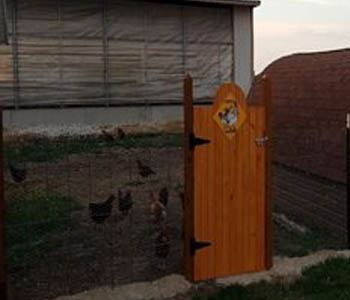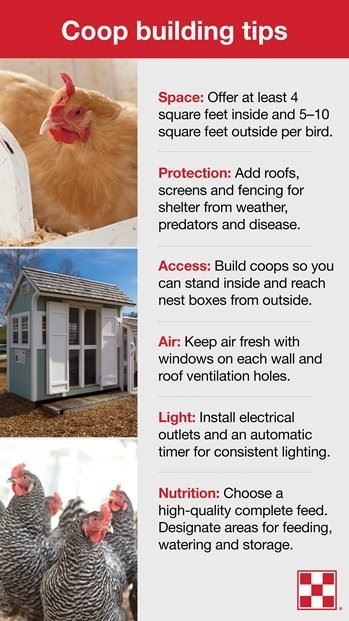How to Build a Chicken Coop
May 22, 2019

How to Build a Chicken Coop: Tips from Team Purina
When planning how to build a chicken coop, keep six points in mind: space, protection, access, air, light and nutrition. Your chicken coop should provide shelter and protection to your chickens along with convenience for you and your family.
“It is just as desirable to build a chicken house as it is to build a cathedral.”
Architect Frank Lloyd Wright said this quote several decades ago. Today, we believe these words still hold meaning. A chicken coop is a home to your birds, providing shelter for your flock and a centerpiece of your backyard.
That’s certainly the case for the 12 chicken coops at the Purina Animal Nutrition Center in Gray Summit, Missouri, where we raise backyard chickens just like our customers. This is where each of our poultry feed recipes begin. Our Ph.D. nutritionists, feed formulators and flock caregivers work with our backyard chickens each day, assuring that each of our feeds is formulated specifically to help backyard birds be Flock Strong®.
For our chicken coops, we focused on a combination of safety and comfort for our birds and convenience for our flock care team.
Here are a few points we kept in mind when we built the 12 chicken coops on our farm:

----Purina Animal Nutrition
When planning how to build a chicken coop, keep six points in mind: space, protection, access, air, light and nutrition. Your chicken coop should provide shelter and protection to your chickens along with convenience for you and your family.
“It is just as desirable to build a chicken house as it is to build a cathedral.”
Architect Frank Lloyd Wright said this quote several decades ago. Today, we believe these words still hold meaning. A chicken coop is a home to your birds, providing shelter for your flock and a centerpiece of your backyard.
That’s certainly the case for the 12 chicken coops at the Purina Animal Nutrition Center in Gray Summit, Missouri, where we raise backyard chickens just like our customers. This is where each of our poultry feed recipes begin. Our Ph.D. nutritionists, feed formulators and flock caregivers work with our backyard chickens each day, assuring that each of our feeds is formulated specifically to help backyard birds be Flock Strong®.
For our chicken coops, we focused on a combination of safety and comfort for our birds and convenience for our flock care team.
Here are a few points we kept in mind when we built the 12 chicken coops on our farm:
- Plenty of space: Coop space for chickens is a key consideration. We follow the rule that each bird should always have indoor and outdoor access. The coop can be likened to the bird’s home, while the run and outdoor area is their playground. Chicks should move to the coop around 6 weeks of age and each receive at least 4 square feet of indoor space and 5-10 square feet of outdoor space.
- Covered room to roam: Each of our chicken coops has a covered outdoor run for the birds to enjoy fresh air. This large, covered area is important for several reasons: One it provides shelter from weather and direct sunlight. Secondly, it provides security from predators. And most importantly, and a factor we normally don’t think about, it provides a measure of biosecurity by not allowing droppings from wild birds to land in the area occupied by chickens. We place our feeders and waterers in the covered runs so the coops stay dry and clean.
- Predator-proof: Having a predator-proof chicken coop is very important. We’ve predator-proofed the Purina® coops by placing screens on the doors, windows and runs. We used galvanized welded wire instead of chicken wire as chicken wire can stretch and allow predators access to the run. We also buried wire underground to prevent burrowing predators from accessing the coop and run. (We buried galvanized welded wire six inches underground, parallel to the walls of the coop and run and then bent the wire 90 degrees to run the wire out from the coop parallel to the ground, 6 inches.) Then we covered the wire with dirt. If a predator tries to dig under the coop or run, they hit the buried welded wire, and stop digging.
- Good ventilation: Fresh air is essential during all seasons. On our chicken coops, we added windows on all 4 sides and ventilation holes at the top of the coops to allow fresh air to enter and stale air to exit. Even if you live in a cold climate, don’t seal the coop from fresh air as ammonia buildup can be hazardous to birds.
- Electrical outlets: As days get shorter, hens need additional light to continue laying eggs. To provide 17 hours of light per day, we added electrical outlets to our chicken coops. This allows us to add one incandescent 40-watt or LED 9 to 13-watt bulb per 100 square feet of coop space. We use an automatic timer to keep light and dark hours consistent so hens stay on a laying and sleeping schedule.
- Continuous access to clean water and fresh feed: Fresh complete feed and clean water are essentials in maintaining a strong, healthy flock. When building a chicken coop, designate areas for feeders and waterers and determine a place for feed storage. If you live in a cold climate, you may need water heaters to prevent water from freezing, but the coop should be built so it does not need to be heated.

----Purina Animal Nutrition